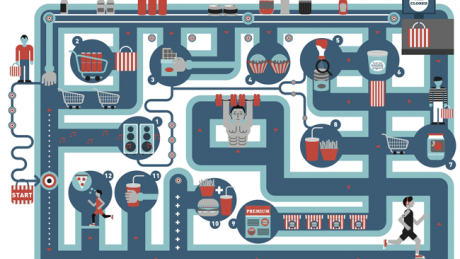
1. Tune out
Many supermarkets play music with a rhythm that’s slower than the average heartbeat, and – according to a study published in the Journal Of Marketing – that makes you spend longer in the store and spend up to 30% more on food you don’t necessarily need. The solution? A set of earphones and your killer playlist.
Spotify’s best playlists to motivate you
2. Bulk-buy with care
‘If you switch from buying a six-pack of fizzy drinks every week to a 12-pack in an attempt to save money, you’ll probably start drinking 12 cans a week,’ says nutritionist Dr Lisa Young, author of The Portion Teller Plan (portionteller.com). ‘Not only are you not saving money, you’re also overeating and drinking. If you’re bulk-buying, stick to household goods like toilet roll or bland foodstuffs like tinned veg and avoid anything you’ll be tempted to binge on.’
3. Remove temptation
Supermarkets will deliberately try to seduce you into making unhealthy impulse buys with strategically placed ‘gondola’ promotions at the end of aisles and confectionary-packed ‘golden zones’ next to the tills. Ensure you avoid temptation by shopping online. A consumer study by eDigital Research found that 29% of shoppers made impulse buys in store, compared with just 7% on the web.
What we think are the best online meal services
4. Buy boring foods first
‘Supermarkets deliberately position bright-coloured fruit and vegetables near the front of the store to put you in a good mood and make you more likely to spend money,’ says Phil Lempert, editor of supermarketguru.com. ‘They also have pleasant-smelling flowers and baked goods near the entrance to activate your salivary glands, which makes you more likely to deviate from your shopping list.’ To avoid this trap, head straight to the ‘boring’ aisles stocked with canned goods, and visit the front of the store last. By this point, you’ll be keen to leave and less easily distracted – plus putting fresh fruit and veg in your trolley last means it’ll be less likely to get squashed by the rest of your shopping.
5. Check for suspect portion sizes
The portion size listed on product packaging is very important, according to the Food Standard Agency’s rules, each manufacturer can decide what they consider to be a single serving of their product and list its values accordingly. This can be used to manipulate food labelling to make a product seem healthier than it is. For example, a manufacturer may claim that one biscuit from a large packet constitutes a serving. If there is up to 0.1g of sodium in that biscuit, the FSA rules allow them to list it as trace or 0g, even though a 400g pack of biscuits – each containing 0.1g – would contain roughly 30% of your sodium RDA.
Get the Coach Newsletter
Sign up for workout ideas, training advice, reviews of the latest gear and more.
6. Avoid ‘low-fat’ foods
‘Most so-called “low-fat” foods have been highly processed to remove the fat and are often packed with salt and sugar to compensate for and enhance the flavour,’ says nutritionist and sports scientist Laurent Bannock (guruperformance.com). Most types of fat – especially heart-healthy polyunsaturated and monounsaturated fats – are good for you, and will help rather than hinder fat loss like sugar does.
7. Know what’s really in your food
Most people realise that if a food has high quantities of sugar on its ingredients label, it probably isn’t going to help with fat loss. Unfortunately, food manufacturers increasingly get around this by sneakily adding smaller doses of lots of different types of sugar, or equally bad sugar substitutes, with names that the average consumer won’t recognise. Questionable ingredients to look out for include dexterose, are used in place of regular sugar. A similar problem occurs with MSG – a food additive that causes fat-storing blood sugar spikes and increases your appetite – which can be listed as glutamate, yeast extract or hydrolysed protein.
8. Use if-then action plans
Research from New York University suggests that forming an if-then plan – ‘if X happens, I will do Y’ – can significantly improve your ability to avoid temptation. Examples could include: ‘If I have to eat when I’m on the go, I’ll get healthier food from M&S rather than a KFC’ or ‘If there’s no option but to go to McDonald’s, I’ll get a coffee or mineral water with my meal rather than a fizzy drink.’ With prepared strategies in place, you’re far less likely to fall off the wagon completely when presented with difficult food choices.
Our list of the best healthy lunch ideas from the high street
9. Be aware that you’re a target
‘Our minds are constantly processing information such as colour, lighting, smells and words on signs,’ says psychologist William Poundstone, author of Rock Breaks Scissors: A Practical Guide To Outguessing And Outwitting Almost Anyone (williampoundstone.net). ‘Studies have shown that these factors affect our decision-making process without us being aware of it. Fast-food restaurants are manipulative places that use these factors to entice you in and convince you to order as much as possible. Examples include the use of the colour red because it activates your hunger and grabs your attention, and the use of words such as “premium” on menus, which affect your decision-making. Simply being aware of these methods makes it easier to counteract and ignore them.’
10. Avoid combo meals
‘Combo meals give you an incentive to order something extra,’ says Poundstone. ‘It costs pennies more to get fries with your burger and drink, so you might as well – you’re practically throwing money away if you don’t order them. But this is only because restaurants deliberately inflate the prices of à la carte items to make the combo meals seem like a bargain. So if you just want a burger, order that, and avoid the extra calories, sugar and salt that come with the optional extras.’
11. Always choose a small drink
‘Most fast-food or coffee-shop chains will offer three sizes for all their beverages, often with enigmatic names to mislead you about their sizes,’ says Poundstone. ‘In this situation, most people will instinctively favour the middle option because it seems the safest, which is known as “extremeness aversion” or the “rule of three”. Restaurants use this for ‘upselling’, by making sure that the middle option is moderately bigger (and more expensive) than the average customer would otherwise order.’ If you’re trying to stay trim, always choose the smallest of the options on offer. It’s highly unlikely that you’ll be left wanting more, and your waistline and wallet will thank you for it.
12. Take a stand
‘Research has shown that if you can resist a strong attempt to persuade you to think or act differently than usual, it will strengthen and reinforce your original attitude, and make you less likely to be persuaded in the future,’ says psychologist Dr Laura Edwards. So next time you’re tempted by fast food, make a conscious point of avoiding it. It’ll be easier to resist on subsequent occasions and your healthy eating beliefs will be strengthened.
Between 2010 and 2016, Ben was the deputy editor of Men’s Fitness UK, which predated, and then shared a website with, Coach. Ben also contributed exclusive features to Coach on topics such as football drills, triathlon training plans and healthy eating.

